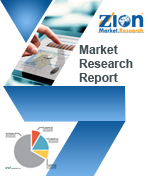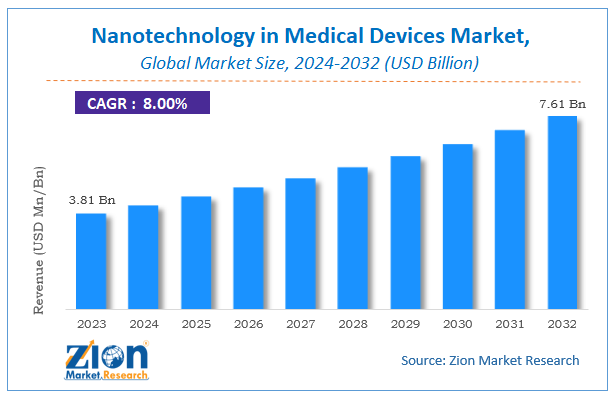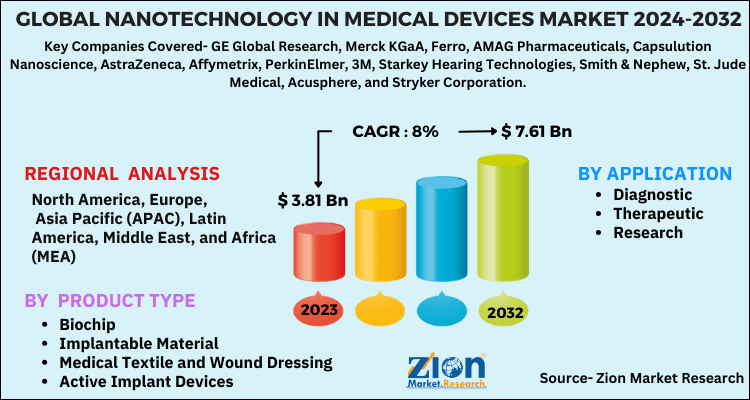Nanotechnology in Medical Devices Market Size, Share, Growth Analysis Report 2032

Nanotechnology in Medical Devices Market by Product Type (Biochip, Implantable Material, Medical Textile & Wounding Dressing, Active Implant Devices, and Others), by Application (Diagnostic, Therapeutic, and Research), and By Region: Global Industry Perspective, Comprehensive Analysis, and Forecast, 2024-2032
| Market Size in 2023 | Market Forecast in 2032 | CAGR (in %) | Base Year |
|---|---|---|---|
| USD 3.81 Billion | USD 7.61 Billion | 8% | 2023 |
Nanotechnology in Medical Devices Industry Perspective:
The global nanotechnology in medical devices market size accrued earnings worth approximately USD 3.81 Billion in 2023 and is predicted to gain revenue of about USD 7.61 Billion by 2032, is set to record a CAGR of nearly 8% over the period from 2024 to 2032.
The study includes the drivers and restraints of the nanotechnology in medical devices market along with their impact on the demand over the forecast period. Additionally, the report includes the study of opportunities available in the nanotechnology in medical devices market on a global and regional level.
Nanotechnology in Medical Devices Market: Overview
Nanomaterial consists of significant nano-scale dependent optical, catalytic, physical, chemical, and electric properties that can be controlled. Nanotechnology’ small size is its utility in the healthcare sector. When these particles enter the biological system, their nanoscale properties along with nano size helps them in delivery probes and vector for therapeutic, diagnostic, and imaging purposes. Due to their reduced size, the surface area of nanotechnology increases which helps in bimolecular chemical interactions. The drug delivery system with non-material can interact with bimolecular present at both the surface and within the cell. This, in turn, provides a significant amount of interaction time between the drug and the cell.
In order to give the users of this report a comprehensive view of the nanotechnology in medical devices market, we have included a competitive landscape and an analysis of Porter’s Five Forces model for the market. The study encompasses a market attractiveness analysis, wherein all the segments are benchmarked based on their market size, growth rate, and general attractiveness.
Nanotechnology in Medical Devices Market: Growth Factors
As per the World Health Organization, cardiovascular diseases (CVDs) are the primary cause of death worldwide. About 17.5 million people died from CVDs in 2015, i.e., 31% of total global deaths. According to the American Cancer Society, cancer is the second most common cause of death in the U.S. and accounts for nearly one of every four deaths. As per the World Health Organization, there were 14 million new cancer cases in 2012 worldwide and 8.8 million cancer-related deaths in 2015. Globally, nearly 1 in every 6 death is caused by cancer. The global burden of CVDs and cancer is increasing, owing to the rising geriatric population base globally. The increasing prevalence of lifestyle-associated life-threatening diseases is expected to be the major driver for the global nanotechnology in medical devices market.
In addition, rising mortality rate and growing awareness and access to modern and advanced therapeutics among the patients are likely to further fuel the global nanotechnology in medical devices market in the upcoming years. Additionally, growing awareness about the advantages of therapy and huge investments made in the research and development of nanotechnology in medical devices are projected to create new growth opportunities for this market.
The report provides company market share analysis to give a broader overview of the key players in the market. In addition, the report also covers key strategic developments of the market including acquisitions & mergers, new product launch, agreements, partnerships, collaborations & joint ventures, research & development, and regional expansion of major participants involved in the market on a global and regional basis.
Nanotechnology in Medical Devices Market: Segmentation
The global nanotechnology in medical devices market is segmented based on product type and application.
By product type, the market includes biochip (lab-on-chip and DNA microarrays), implantable material (dental filling material, and bone restoring material), medical textile and wound dressing, active implant devices (cardiac rhythm management devices, hearing aid devices, and retinal implants), and others.
On the basis of application, the nanotechnology in medical devices market is divided into diagnostic, therapeutic, and research.
Nanotechnology in Medical Devices Market: Report Scope
| Report Attributes | Report Details |
|---|---|
| Report Name | Nanotechnology in Medical Devices Market |
| Market Size in 2023 | USD 3.81 Billion |
| Market Forecast in 2032 | USD 7.61 Billion |
| Growth Rate | CAGR of 8% |
| Number of Pages | 203 |
| Key Companies Covered | GE Global Research, Merck KGaA, Ferro, AMAG Pharmaceuticals, Capsulution Nanoscience, AstraZeneca, Affymetrix, PerkinElmer, 3M, Starkey Hearing Technologies, Smith & Nephew, St. Jude Medical, Acusphere, and Stryker Corporation |
| Segments Covered | By product type, By application and By Region |
| Regions Covered | North America, Europe, Asia Pacific (APAC), Latin America, Middle East, and Africa (MEA) |
| Base Year | 2023 |
| Historical Year | 2018 to 2022 |
| Forecast Year | 2024 - 2032 |
| Customization Scope | Avail customized purchase options to meet your exact research needs. Request For Customization |
Nanotechnology in Medical Devices Market: Regional Insights
The North American nanotechnology in medical devices market is expected to show the maximum growth over the forecast time period, owing to the developments witnessed in the healthcare infrastructure, favorable government policies and research grant. Europe was the second largest nanotechnology in medical devices market globally in 2018, due to the high per capita income of the regional population. Asia Pacific is expected to show the fastest growth rate while the Latin American market is projected to grow moderately in the years ahead.
Nanotechnology in Medical Devices Market: Competitive Space
The global nanotechnology in medical devices market profiles key players such as:
- GE Global Research
- Merck KGaA
- Ferro
- AMAG Pharmaceuticals
- Capsulution Nanoscience
- AstraZeneca
- Affymetrix
- PerkinElmer
- 3M
- Starkey Hearing Technologies
- Smith & Nephew
- St. Jude Medical
- Acusphere
- and Stryker Corporation.
This report segments the global nanotechnology in medical devices market into:
Global Nanotechnology in Medical Devices Market: By Product Type
- Biochip
- Lab-On-Chip
- DNA Microarrays
- Implantable Material
- Dental Filling Material
- Bone Restoring Material
- Medical Textile and Wound Dressing
- Active Implant Devices
- Cardiac Rhythm Management Devices
- Hearing Aid Devices
- Retinal Implants
- Others
Global Nanotechnology in Medical Devices Market: By Application
- Diagnostic
- Therapeutic
- Research
Global Nanotechnology in Medical Devices Market: By Region
- North America
- The U.S.
- Europe
- UK
- France
- Germany
- Asia Pacific
- China
- Japan
- India
- Latin America
- Brazil
- Middle East and Africa
Table Of Content
Methodology
FrequentlyAsked Questions
The utilisation of nanoscale materials and structures (typically smaller than 100 nanometres) in medical devices is a form of nanotechnology that is designed to improve the precision, functionality, and performance of these devices. Nanotechnology has the potential to enhance the efficacy of medical implants, treatments, and diagnostics by capitalising on the distinctive characteristics of nanomaterials, including increased surface area, enhanced electrical conductivity, and enhanced mechanical strength.
Which key factors will influence the nanotechnology in medical devices market growth over 2024-2032?
The applications of nanotechnology in medical devices are being expanded by the continuous innovation in nanomaterials, including nanosensors, nanocoatings, and nanorobots. These developments enhance the overall efficacy of the device, as well as the precision of treatment and diagnostic accuracy.
The global nanotechnology in medical devices market size accrued earnings worth approximately USD 3.81 Billion in 2023 and is predicted to gain revenue of about USD 7.61 Billion by 2032.
The global nanotechnology in medical devices market a CAGR of nearly 8% over the period from 2024 to 2032.
The regional segment includes the current and forecast demand for North America, Europe, Asia Pacific, Latin America, and the Middle East and Africa with its further classification into major countries including the U.S., UK, Germany, France, China, Japan, India, Brazil, etc.
GE Global Research, Merck KGaA, Ferro, AMAG Pharmaceuticals, Capsulution Nanoscience, AstraZeneca, Affymetrix, PerkinElmer, 3M, Starkey Hearing Technologies, Smith & Nephew, St. Jude Medical, Acusphere, and Stryker Corporation
RelatedNews
HappyClients
Zion Market Research
Tel: +1 (302) 444-0166
USA/Canada Toll Free No.+1 (855) 465-4651
3rd Floor,
Mrunal Paradise, Opp Maharaja Hotel,
Pimple Gurav, Pune 411061,
Maharashtra, India
Phone No +91 7768 006 007, +91 7768 006 008
US OFFICE NO +1 (302) 444-0166
US/CAN TOLL FREE +1 (855) 465-4651
Email: sales@zionmarketresearch.com
We have secured system to process your transaction.
Our support available to help you 24 hours a day, five days a week.
Monday - Friday: 9AM - 6PM
Saturday - Sunday: Closed






